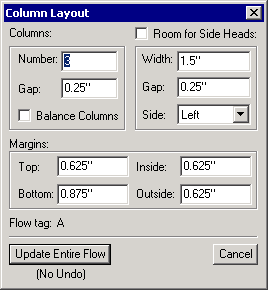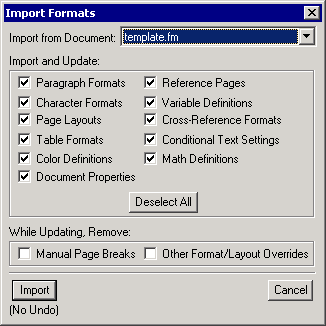FrameMaker 7.0 Tutorial: Templates
About Templates
A template is a document that consists of a predefined set of styles, page layout definitions (page size, margins, etc.), and special text. Templates are used to format other documents. Templates are valuable because:
Templates save time. Templates make large-scale, professional documentation projects more manageable. Instead of opening a blank document and designing the styles and page layouts every time you create a new document, you open a template that contains the styles and page layout definitions created for your documentation library.
Templates provide consistency. If you work on large documents over a long period of time, or work with other people on the same document, maintaining consistency throughout a documentation library is crucial. Templates help ensure that the page formats are consistent across all documents.
Exploring FrameMaker Templates
FrameMaker offers default templates for a variety of styles and page layouts.
To explore FrameMaker templates:
- Open FrameMaker.
- Select File > New > Document.
- In the New dialog box, click Explore Standard Templates.
- Click Down, and then select the Newsletter template.
- Click Show Sample.
A sample document appears in the document window.
- Within the sample document, place your cursor in the body of the documnent.
The name of the paragraph tag appears in the bottom-left corner of the document window.
- Select Format > Page Layout > Column Layout.
The Column Layout dialog box appears.

This template contains three columns.
- Click Cancel to return to the document.
- Open the Paragraph Catalog.
Notice the different paragraph tags that have been created for this template.
Modifying FrameMaker Templates
To modify a FrameMaker template:
- With the Newsletter template open, place your cursor in the title area of the document.
Notice that you cannot select the text.
- Select View > Master Pages, and place your cursor in the title area.
The Title paragraph tag name appears in the corner of the document window. You can select and edit the title text from only the master page.
- Change the title text and the company name.
- Select View > Body Pages to return to the body pages.
- Close the document. (If you want to save your changes, click Save when prompted.)
Creating Custom Templates
In this procedure, you modify the default FrameMaker template to create a custom template.
To create a custom template:
- Open a new document, and select File > Save.
FrameMaker opens a new document using the default template.
- In the File name box, type template.fm, and click Save.
Note: If you are working in the TCM computer lab, save the file to your lab account. If you do not have a lab account, please contact your instructor. - Change the pagination to double-sided:
- Select Format > Page Layout >Pagination.
- In the Pagination dialox box, select Double-Sided.
- From the 1st Page Side pull-down menu, select Right, and click Set.
- Change the size of the page:
- Select Format > Page Layout > Page Size.
- In the Page Size dialog box, select Custom from the Page Size pull-down menu.
- In the Width box, type 4.
- In the Height box, type 8.
- Click Set.
- Change the column layout:
- Select Format > Page Layout > Column Layout.
- In the Margins area, type .40 in the Top and Bottom boxes.
- In the Inside box, type 0.50, and in the Outside box, type 0.25.
- Click Update Entire Flow.
- Press and hold the Enter key until you create a second page. (The first page is filled with paragraph symbols.)
Notice the left margin differs on the right and left pages. You can view these differences on the master page. Select View > Master Pages, and scroll through the master pages.
Also, notice that the master pages contain text frames for headers and footers. These frames are located at the top and bottom of the two master pages, one for the left page and one for the right. These frames do not appear on body page because you can edit headers and footers only on the master pages.
- While the master pages are visible, create the headers and footers:
- Use the Previous Page/Next Page buttons at the bottom of the FrameMaker window to find and display the right page.
The name of the master page appears in the center of the Framemaker status bar.
- Place your cursor within the header frame of the right page, and type FrameMaker Tutorials.
- Within the left page header frame, type Abobe FrameMaker 7.0.
- Within the right page footer frame, type Page, and press the space bar once.
- Select Format > Headers & Footers > Insert Page #.
- Repeat the steps above for the left page footer.
- Select View > Body Pages to view your template.
- Hold down the Enter key to create several new pages. (These pages are filled with paragraph symbols.)
Notice that the headers alternate and the page numbers increment.
- Save and close your template.
Using Custom Templates
To use a custom template:
- Select File > New > Document.
- From the Look in pull-down menu, select the directory in which you saved your template.
- Select template.fm, and click New.
A new document based on your custom template appears.
Importing Formats from a Template
In addition to creating new documents based on a template, you can import individual formats from the template. This feature is valuable when, for example, your documents include different page layouts, but must use the same paragraph and character formats.
To update formats from a template:
- Create a new document, and add some text.
- Open template.fm and the document that you wish to update.
- With the new document window active, select File > Import > Formats.
The Import Formats dialog box appears.

- From the Import from Document pull-down menu, select template.fm.
- From the Import and Update area, select the options that you wish to import.
- Click Import.
The selected options are updated within your document.


Comments